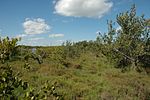Cocoa Beach Glass Bank
Buildings and structures in Florida
The Cocoa Beach Glass Bank, officially known as The First Federal Savings & Loan Association of Cocoa – Cocoa Beach Branch, was a five-story glass building in Cocoa Beach, Florida. It officially opened in April 1962, and fell into disrepair in the late 1970s after the end of the space race.
Excerpt from the Wikipedia article Cocoa Beach Glass Bank (License: CC BY-SA 3.0, Authors).Cocoa Beach Glass Bank
North Atlantic Avenue,
Geographical coordinates (GPS) Address Nearby Places Show on map
Geographical coordinates (GPS)
| Latitude | Longitude |
|---|---|
| N 28.32596 ° | E -80.60954 ° |
Address
Chevron Food Mart
North Atlantic Avenue 400
32931
Florida, United States
Open on Google Maps



